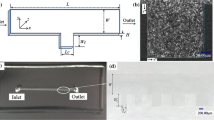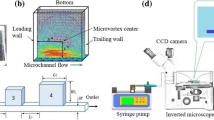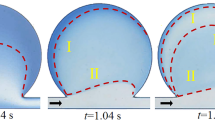Abstract
Low-Reynolds-number flows in cavities, characterized by separating and recirculating flows are increasingly used in microfluidic applications such as mixing and sorting of fluids, cells, or particles. However, there is still a lack of guidelines available for selecting the appropriate or optimized microcavity configuration according to the specific task at hand. In an effort to provide accurate design guidelines, we investigate quantitatively low-Reynolds-number cavity flow phenomena using a microfluidic screening platform featuring rectangular channels lined with cylindrical cavities. Using particle image velocimetry (PIV), supported by computational fluid dynamics (CFD) simulations, we map the entire spectrum of flows that exist in microcavities over a wide range of low-Reynolds numbers (Re = 0.1, 1, and 10) and dimensionless geometric parameters. Comprehensive phase diagrams of the corresponding microcavity flow regimes are summarized, capturing the gradual transition from attached flow to a single vortex and crossing through two- and three-vortex recirculating systems featuring saddle-points. Finally, we provide design insights into maximizing the rotational frequencies of recirculating single-vortex microcavity systems. Overall, our results provide a complete and quantitative framework for selecting cavities in microfluidic-based microcentrifuges and vortex mixers.







Similar content being viewed by others
References
Chiu D (2007) Cellular manipulations in microvortices. Anal Bioanal Chem 387:17–20
Cioffi M, Moretti M, Manbachi A, Chung BG, Khademhosseini A, Dubini G (2010) A computational and experimental study inside microfluidic systems: the role of shear stress and flow recirculation in cell docking. Biomed Microdevices 12:619–626
Duffy DC, McDonald JC, Schueller OJA, Whitesides GM (1998) Rapid prototyping of microfluidic systems in poly(dimethylsiloxane). Anal Chem 70:4974–4984
Heaton CJ (2008) On the appearance of Moffatt eddies in viscous cavity flow as the aspect ratio varies. Phys Fluids 20:103102–103111
Hellou M, Coutanceau M (1992) Cellular stokes flow induced by rotation of a cylinder in a closed channel. J Fluid Mech 236:557–577
Higdon JJL (1985) Stokes flow in arbitrary two-dimensional domains: shear flow over ridges and cavities. J Fluid Mech 159:195–226
Horner M, Metcalfe G, Wiggins S, Ottino JM (2002) Transport enhancement mechanisms in open cavities. J Fluid Mech 452:199–229
Hur SC, Mach AJ, di Carlo D (2011) High-throughput size-based rare cell enrichment using microscale vortices. Biomicrofluidics 5:022206–022210
Iwatsu R, Ishii K, Kawamura T, Kuwahara K, Hyun JM (1989) Numerical simulation of three-dimensional flow structure in a driven cavity. Fluid Dyn Res 5:173–189
Khabiry M, Chung B, Hancock M, Soundararajan H, Du Y, Cropek D, Lee W, Khademhosseini A (2009) Cell docking in double grooves in a microfluidic channel. Small 5:1186–1194
Leneweit G, Auerbach D (1999) Detachment phenomena in low Reynolds number flows through sinusoidally constricted tubes. J Fluid Mech 387:129–150
Leong CW, Ottino JM (1989) Experiments on mixing due to chaotic advection in a cavity. J Fluid Mech 209:463–499
Lim DSW, Shelby JP, Kuo JS, Chiu DT (2003) Dynamic formation of ring-shaped patterns of colloidal particles in microfluidic systems. Appl Phys Lett 83:1145–1147
Mach AJ, Kim JH, Arshi A, Hur SC, Di Carlo D (2011) Automated cellular sample preparation using a centrifuge-on-a-chip. Lab Chip 11:2827
Meinhart CD, Wereley ST, Santiago JG (2000) A PIV algorithm for estimating time-averaged velocity fields. J Fluids Eng 122:285–289
Moffatt HK (1964) Viscous and resistive eddies near a sharp corner. J Fluid Mech 18:1–18
O’Brien V (1972) Closed streamlines associated with channel flow over a cavity. Phys Fluids 15:2089–2097
O’Neill ME (1977) On the separation of a slow linear shear flow from a cylindrical ridge or trough in a plane. Zeitschrift für angewandte Mathematik und Physik ZAMP 28:439–448
Olsen MG, Adrian RJ (2000) Out-of-focus effects on particle image visibility and correlation in microscopic particle image velocimetry. Exp Fluids 29:S166–S174
Patil DV, Lakshmisha KN, Rogg B (2006) Lattice Boltzmann simulation of lid-driven flow in deep cavities. Comput Fluids 35:1116–1125
Pozrikidis C (1994) Shear flow over a plane wall with an axisymmetric cavity or a circular orifice of finite thickness. Phys Fluids 6:68–79
Rashidnia N, Balasubramaniam R (1991) Thermocapillary migration of liquid droplets in a temperature gradient in a density matched system. Exp Fluids 11:167–174
Shah RK, London AL (1978) Laminar flow forced convection in ducts. Academic Press, New York
Shankar PN (1993) The eddy structure in stokes flow in a cavity. J Fluid Mech 250:371–383
Shankar PN (1997) Three-dimensional eddy structure in a cylindrical container. J Fluid Mech 342:97–118
Shankar PN, Deshpande MD (2000) Fluid mechanics in the driven cavity. Annu Rev Fluid Mech 32:93–136
Shelby JP, Chiu DT (2004) Controlled rotation of biological micro- and nano-particles in microvortices. Lab Chip 4:168
Shelby JP, Lim DSW, Kuo JS, Chiu DT (2003) Microfluidic systems: high radial acceleration in microvortices. Nature 425:38
Shelby JP, Mutch SA, Chiu DT (2004) Direct manipulation and observation of the rotational motion of single optically trapped microparticles and biological cells in microvortices. Anal Chem 76:2492–2497
Shen C, Floryan JM (1985) Low Reynolds number flow over cavities. Phys Fluids 28:3191–3202
Stocker M (2006) Microorganisms in vortices: a microfluidic setup. Limnol Oceanogr Methods 4:392–398
Sznitman J, Rösgen T (2008) Acoustic streaming flows in a cavity: an illustration of small-scale inviscid flow. Physica D 237:2240–2246
Sznitman J, Rösgen T (2010) Visualization of low Reynolds boundary-driven cavity flows in thin liquid shells. J Vis 13:49–60
Taneda S (1979) Visualization of separating stokes flows. J Phys Soc Jpn 46:1935–1942
Tobak M, Peake DJ (1982) Topology of three-dimensional separated flows. Annu Rev Fluid Mech 14:61–85
Wieneke P (2010) Adaptive PIV with variable interrogation window size and shape. In: 15th international symposium on applications of laser techniques to fluid mechanics
Yu ZTF, Lee YK, Wong M, Zohar Y (2005) Fluid flows in microchannels with cavities. J Microelectromech Syst 14:1386–1398
Acknowledgments
The authors would like to thank P. Hofemeier and Prof. M. Bercovici for helpful discussions. This study was supported in part by the European Commission (FP7 Program) through a Career Integration Grant (PCIG09-GA-2011-293604), the Israel Science Foundation (Grant nr. 990/12), and a Horev Fellowship (Leaders of Science and Technology Program, Technion). Dr. M. K. Mulligan was supported in part by a Technion postdoctoral fellowship. Microfabrication was conducted in the Micro Nano Fabrication Unit at the Technion.
Author information
Authors and Affiliations
Corresponding author
Electronic supplementary material
Below is the link to the electronic supplementary material.
Rights and permissions
About this article
Cite this article
Fishler, R., Mulligan, M.K. & Sznitman, J. Mapping low-Reynolds-number microcavity flows using microfluidic screening devices. Microfluid Nanofluid 15, 491–500 (2013). https://doi.org/10.1007/s10404-013-1166-0
Received:
Accepted:
Published:
Issue Date:
DOI: https://doi.org/10.1007/s10404-013-1166-0




